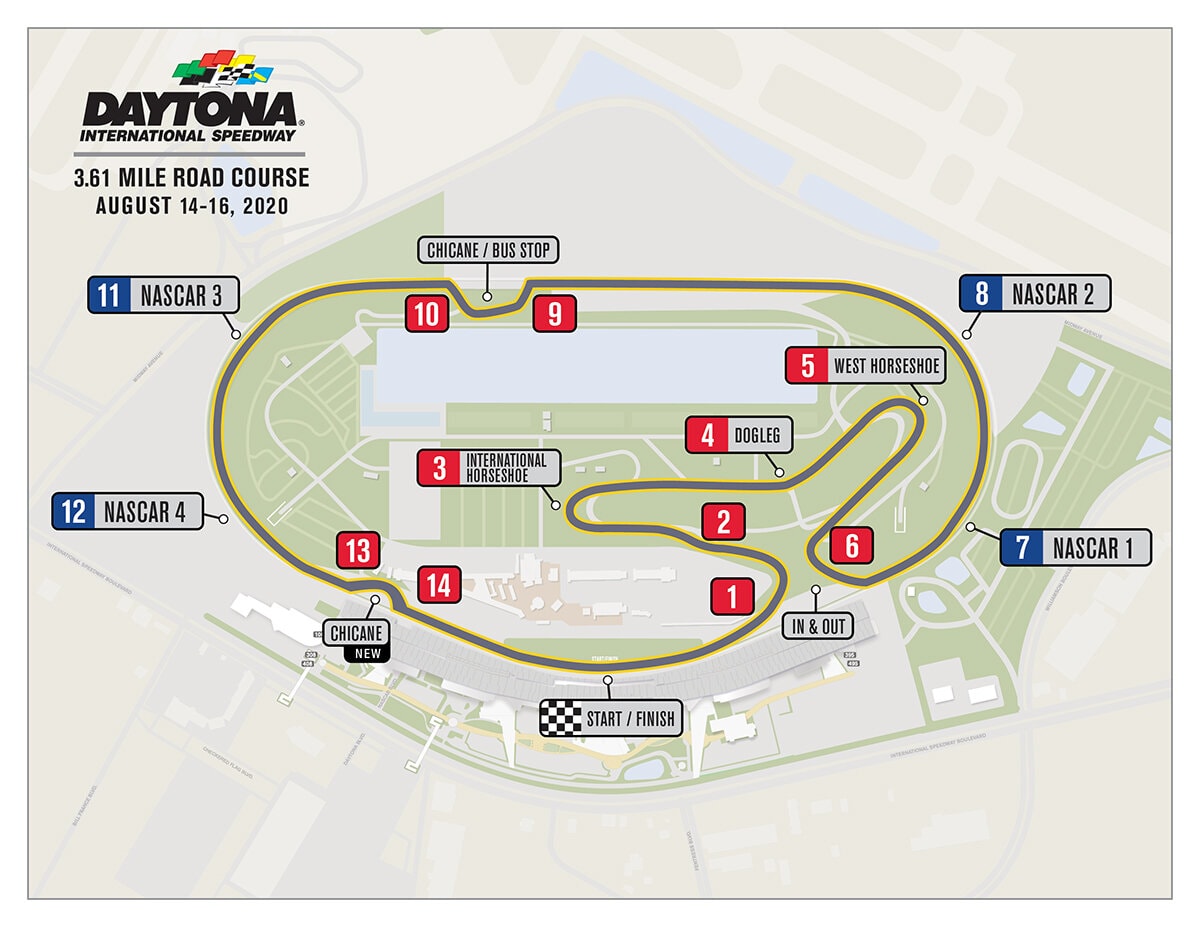All of NASCAR’s touring series will return to the beach at Daytona International Speedway this weekend. However instead of high-speed superspeedway racing, Daytona International Speedway will debut the road course for the first time in NASCAR competition. Not only have teams and drivers never competed on the road course at Daytona but every series will have to prepare for green flag racing without a single lap of practice. It is an unprecedented scenario that is bound to yield chaos in the midst of each series’ points battle for the playoffs. Obviously it is not the most ideal betting situation but this week’s race at Daytona could provide an opportunity for a new driver to visit victory lane.
Before we get into breakdowns of each race this weekend (which will come later in the week), I wanted to provide a breakdown of the Daytona International Speedway Road Course. There is absolutely no way to know how things will unfold this weekend for each series and any “handicapper” pretending to have an edge towards these races is a complete fraud. There is no angle, model, or anything that can accurately suggests what will transpire for each series this weekend. However, there are some things that we can do to strengthen our betting insight and it all starts with learning the new road course that will be unveiled to the viewing audience this weekend. Hopefully we can take some of the information and embrace the uncertainty to identify a few unique betting opportunities for later in the week!
Daytona Road Course Layout
The road course at Daytona features a 3.61 mile layout that encompasses 14 identifiable turns. The start/finish line remains unchanged and the best description of the road course section of the course involves turns 1-6. After crossing the start/finish line, cars will slow down to enter a sweeping pair of corners that will bring them parallel to the front stretch in the opposite direction. After coming out of turn 2, cars will gain speed until they come to a pair of right-hand paper-clip style turns. Turns 3 and 5 are similar right-hand paper-clip style turns with a slight dogleg left (turn 4) in the middle of the ¾ mile stretch. After coming out of the final right-hand turn (5) in the infield section of the road course, cars will enter a low-speed area of the track with a sharp left-hand turn (6) before entering the traditional oval portion of Daytona International Speedway.
Cars will utilize the majority of the 2.5 mile traditional oval at Daytona which will undoubtedly be the highest speed areas of the course. There are two “chicanes” on the traditional oval portion of the course which will yield a lot of drama. The first chicane (also called the bus stop) is located on the back stretch before entering the turn 3 oval and another chicane is located on the front stretch coming out of the turn 4 oval. Both chicanes will be “action” areas of the track this weekend because cars will be carrying a ton of speed as they enter both of these critical braking zones. After cars exit the final chicane(turns 13-14) on the front stretch, it will be a race back to the start/finish line to conclude the 3.61 mile journey.
Observations and Notes
This weekend’s races at Daytona’s road course are replacing races originally scheduled to be held at Watkins Glen International. However, this new road course at Daytona does not share many characteristics to Watkins Glen or Sonoma for that matter. Instead, this road course is most similar to the ROVAL at Charlotte. The entire layout nearly mimics the ROVAL with some slightly different corner angles at the infield portion of the course. While the similarities with the ROVAL are undeniable, I don’t believe the racing will be completely identical.
From a handicapping perspective, I definitely believe we can utilize results from the ROVAL over the last two years to provide a baseline of expectations. Afterwards, I think we have to give slightly more credibility towards raw speed. While this is a road course venue, the majority of the lap will be on the traditional oval section of the course. Typically road courses neutralize aerodynamic horsepower advantages from the fastest teams in the garage. However, I don’t believe we should overlook raw speed completely this weekend due to the speed and amount of time that will be required on the traditional oval section of the course.
Even though I believe I am looking at things the right way as the weekend approaches, we still must accept that teams and drivers will still not have any practice time prior to each race. Therefore even if we are handicapping this race in the best way plausible, we still must deal with teams that may completely miss the setup or drivers that could make costly mistakes as they attempt to get accustomed to this new layout. Therefore, this weekend’s races require heavy discipline from bettors to ensure betting selections yield sufficient value for the risk that will be in-play.
Be sure to check back later this week for the preview for each race along with betting selections and Draftkings fantasy racing advice!

